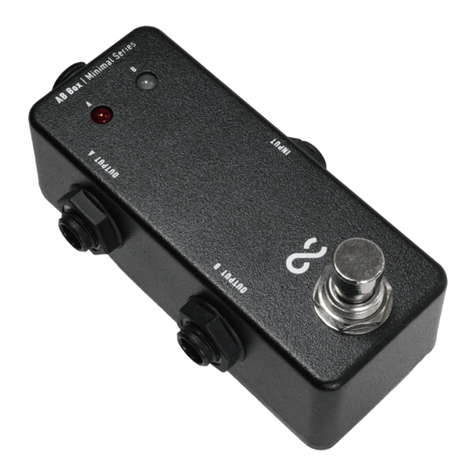
In setup 5 we utilise the buffer circuit, 4 loops from loops 1 to 7 which are then running directly into the
amplifier input, using the FX send of the amp we are returning the signal into loop 8 through loop 9 and
then back to the FX return of the amplifier.
Utilising the Buffer circuit will give the signal increased strength and retention of clarity, primarily this
circuit is designed for running longer cable runs and running through multiple effects units which ulti-
mately can lower signal strength and dull the top end of the signal.
Loops 1,2,3 and 4 are being utilised in setup 5. loops 1 thru 7 are internally connected so signal from
main input will always be running to OUT 1 and OUT 2 whether pedals are connected or not.
Out 2 is utilised in setup 5 as it is the most conveniently placed to run signal into the amplifier input.
The signal is returned to the OC10 from the amplifier via the FX loop send into Loop IN 8 on the OC10
In setup 5 you can see that the echo unit in Loop 8 is connected via the S8 (Send 8) and R8 (Return 8)
sockets, the signal is then sent via a short patch cable (Linked) from OUT8(N.O) to IN9, if this is not
done no signal will be running into loop 9 as loops 8, 9 and 10 are not internally connected and do not
pass signal through to the next loop unless they are connected together.
Repeating the same method used to connect the echo, the reverb in setup 5 is connected via the S9
(Send 9) and R9 (Return 9) sockets, the signal is then sent via OUT9(N.O) to the amplifier FX return
Setup 5 utilises the Midi facilities of the OC10 running the Midi out to the Midi in of the delay unit, Midi
on the OC10 is only transmitted on Channel 1 and cannot be changed, Midi will work on presets 1 to
70, there is no Midi mapping on the OC10 so presets and midi numbers are exactly the same, for ex-
ample, preset 1 = midi patch number 1, preset 2 = midi patch number 2, preset 10 = midi patch num-
ber 10
Activating the Midi on the OC10 is similar to activating the loops on the OC10 and is done via the Midi
On/Off switch, to transmit Midi the TX light must be lit on the preset you are storing otherwise Midi in-
formation will not be sent to the receiving unit on that preset. The RX light only needs to be lit when
Midi is being received by the OC10.
More on Amplifier FX Loops
FX loops fall into two categories those being Parallel and Series.
Parallel loops were primarily designed to combat signal degradation due to poor quality FX by not running
the whole signal after the preamp through the FX, but by splitting the signal into two signals paths running in
Parallel as the name suggests, one signal goes through the FX unit and is called the wet signal or effected
signal, the other does not run through the effect and is called the dry signal or non effected signal.
Parallel FX loops will always have a mix or FX level dial on the amp so if in doubt of which type your amp has
look for this feature. Parallel loops can sometimes cause the effect and dry signal to be out of phase, this is
most common on older Mesa Boogie amps.
Series FX loops have no FX loop level or mix dial as they are sending the full signal from the preamp through
the FX in the loop, the mix is determined by the amount of mix of wet to dry signal you assign on the FX unit.
As the quality of FX units has improved drastically over recent years more amps are featuring series FX
loops.
There are a few models of amplifiers that feature switchable FX loops or similar and have the ability to run in
either Series or Parallel mode, some Laney amps and newer Mesa Boogie amps have this feature.
SETUP 5 PAGE 2



























